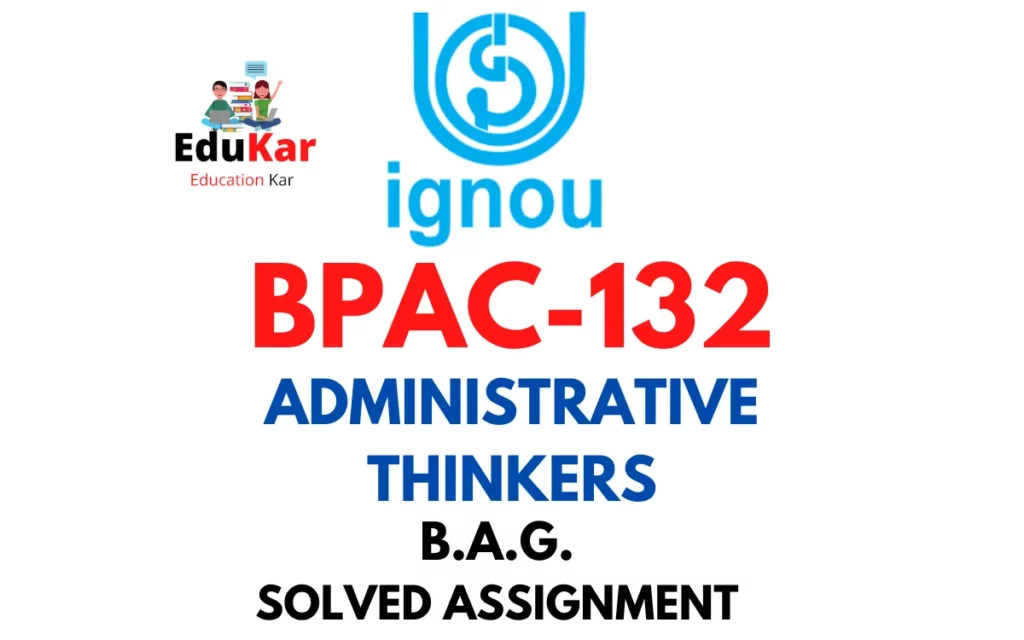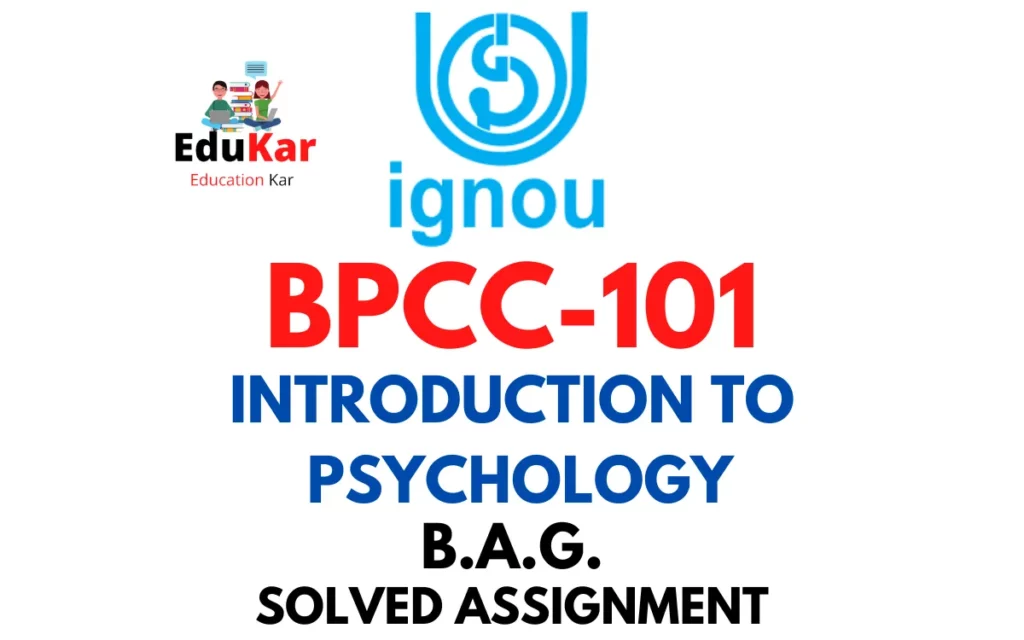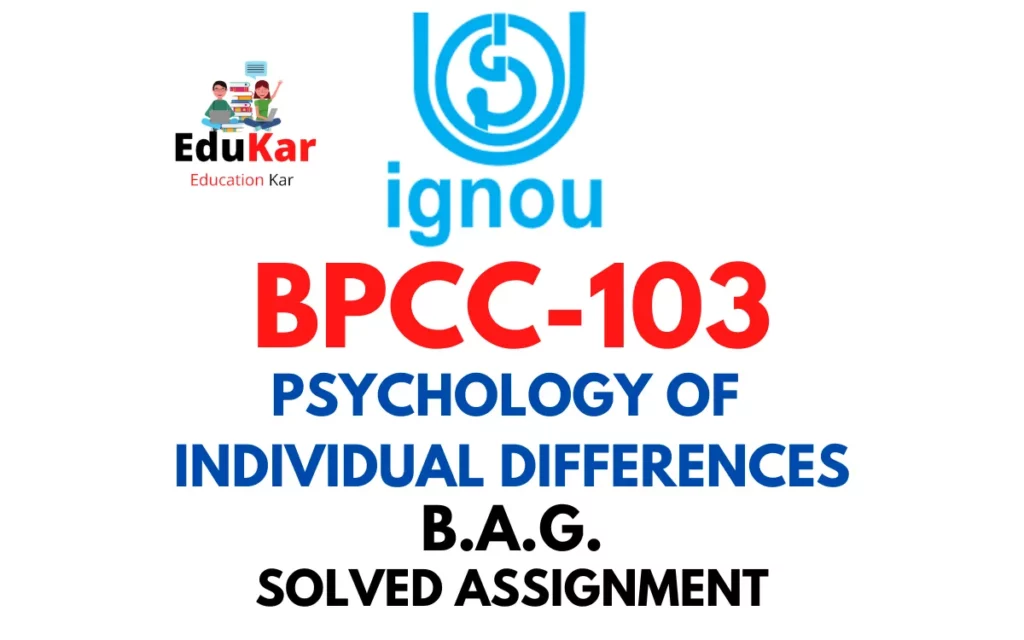Contents
- 1 Assignment One
- 2 Answer the following descriptive category questions in about 500 words each. Eachquestion carries 20 marks.
- 3 1. Explain the four basic components of psychological capital required for positiveorganizational Behavior.
- 4 2. Explain the causes and consequences of stress. Describe the various techniques ofmanaging stress.
- 5 3. Describe the bases of power and concept of dependency. Discuss the various powertactics.
- 6 Assignment Two
- 7 Answer the following short category questions in about 100 words each. Each question carries 5 marks.
- 8 4. Action Research Model.
- 9 5. Strategies to manage the organizational resistance for change.
- 10 6. Functions of Communication.
- 11 7. Process Theories of motivation.
- 12 8. Work Situation Characteristics.
- 13 9. Relevance of Work Values for an Effective Organization.
- 14 10. Characteristics of the Field of OB Today.
- 15 11. Contemporary Issues and Challenges.

| Title | BPCC-112: IGNOU BAG Solved Assignment 2022-2023 |
| University | IGNOU |
| Degree | Bachelor Degree Programme |
| Course Code | BPCC-112 |
| Course Name | ORGANIZATIONAL BEHAVIOR |
| Programme Name | Bachelor of Arts (General) |
| Programme Code | BAG |
| Total Marks | 100 |
| Year | 2022-2023 |
| Language | English |
| Assignment Code | Asst /TMA /2022-23 |
| Assignment PDF | Click Here |
| Last Date for Submission of Assignment: | For June Examination: 31st April For December Examination: 30th September |
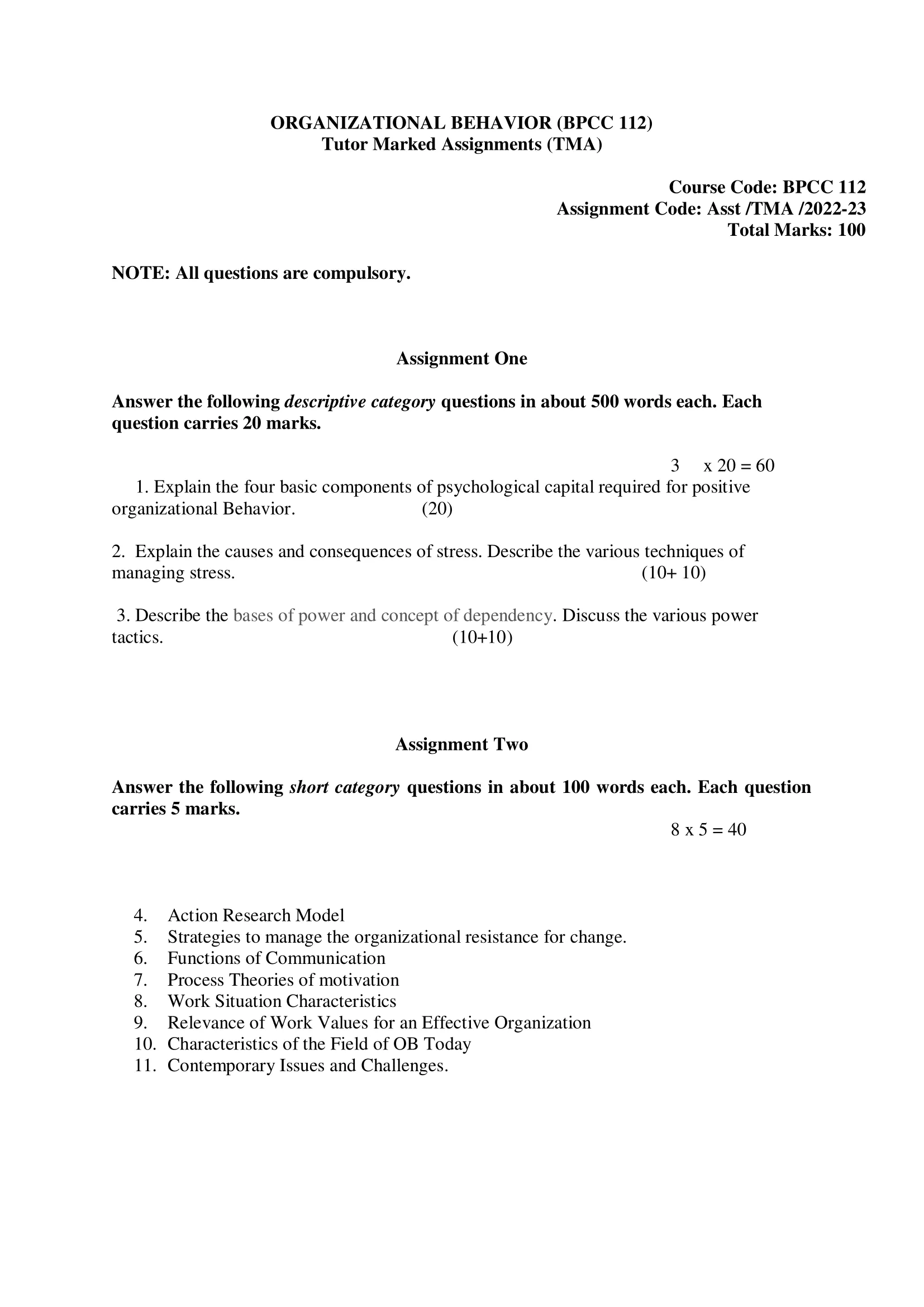
Assignment One
Answer the following descriptive category questions in about 500 words each. Each
question carries 20 marks.
1. Explain the four basic components of psychological capital required for positive
organizational Behavior.
Ans: Psychological capital, or PsyCap, refers to an individual’s positive psychological resources that can help them to thrive and succeed in the workplace. Positive organizational behavior is a field of study that focuses on promoting well-being and positive outcomes in the workplace. The four basic components of psychological capital required for positive organizational behavior are:
- Self-efficacy: Self-efficacy refers to an individual’s belief in their ability to successfully perform a task or achieve a goal. Employees with high levels of self-efficacy are more likely to take on challenging tasks, persist in the face of obstacles, and perform at a higher level. In the workplace, managers can foster self-efficacy by providing employees with training and development opportunities, setting achievable goals, and providing constructive feedback.
- Hope: Hope refers to an individual’s belief in their ability to create a positive future outcome and their willingness to work towards achieving that outcome. Employees with high levels of hope are more likely to set ambitious goals, persist in the face of setbacks, and maintain a positive outlook. In the workplace, managers can foster hope by providing employees with a clear sense of purpose, a vision for the future, and opportunities for growth and development.
- Optimism: Optimism refers to an individual’s expectation that good things will happen in the future, and their belief that they have the ability to shape their own future. Employees with high levels of optimism are more likely to be resilient in the face of challenges, maintain a positive attitude, and experience greater job satisfaction. In the workplace, managers can foster optimism by providing employees with a positive and supportive work environment, recognizing and celebrating successes, and encouraging employees to see challenges as opportunities for growth.
- Resilience: Resilience refers to an individual’s ability to recover quickly from setbacks, adapt to change, and persist in the face of adversity. Employees with high levels of resilience are more likely to bounce back from difficult situations, remain focused and engaged, and perform at a high level. In the workplace, managers can foster resilience by providing employees with the resources and support they need to overcome challenges, promoting a culture of learning and growth, and encouraging employees to take risks and learn from their mistakes.
2. Explain the causes and consequences of stress. Describe the various techniques of
managing stress.
Ans: Stress is a natural response to the demands and challenges of daily life. It is a physiological and psychological response that occurs when an individual perceives a situation as threatening or demanding, and their body prepares to respond to that threat. While a certain amount of stress can be beneficial in motivating and energizing individuals, chronic or excessive stress can have negative effects on an individual’s physical and mental health, as well as their work performance and quality of life.
Causes of Stress: There are a number of factors that can cause stress. These include:
- Work-related stress: Work-related stress can be caused by a number of factors, including job demands, workload, role conflict, lack of control over work, interpersonal conflict, and job insecurity.
- Personal life stress: Personal life stress can be caused by events such as relationship problems, financial difficulties, illness, and major life changes such as moving or starting a new job.
- Environmental stress: Environmental stress can be caused by factors such as noise, pollution, and crowding.
- Physiological stress: Physiological stress can be caused by factors such as illness, injury, or chronic pain.
Consequences of Stress: Chronic or excessive stress can have a number of negative consequences on an individual’s physical and mental health, as well as their work performance and quality of life. These include:
- Physical health problems: Chronic stress can lead to a number of physical health problems, including heart disease, high blood pressure, and gastrointestinal problems.
- Mental health problems: Chronic stress can also lead to a number of mental health problems, including depression, anxiety, and burnout.
- Reduced work performance: Chronic stress can reduce an individual’s work performance by impairing their concentration, memory, and decision-making ability.
- Interpersonal problems: Chronic stress can also lead to interpersonal problems, including conflict with co-workers, family members, and friends.
Techniques for Managing Stress: There are a number of techniques that can be used to manage stress. These include:
- Exercise: Exercise is a great way to reduce stress, as it releases endorphins and improves physical health.
- Relaxation techniques: Relaxation techniques such as deep breathing, meditation, and progressive muscle relaxation can help to reduce stress and promote relaxation.
- Time management: Effective time management can help to reduce stress by prioritizing tasks and minimizing time pressure.
- Social support: Talking to friends, family members, or a therapist can help to reduce stress by providing emotional support and perspective.
- Cognitive-behavioral therapy: Cognitive-behavioral therapy is a type of therapy that can help to reduce stress by changing negative thought patterns and behaviors.
- Mindfulness: Mindfulness practices such as yoga, tai chi, or mindful breathing can help to reduce stress by promoting awareness and relaxation.
3. Describe the bases of power and concept of dependency. Discuss the various power
tactics.
Ans: Power is the ability to influence the behavior of others, and it is an important aspect of organizational behavior. There are various bases of power that individuals or groups can use to influence others, and understanding these bases is crucial to effective management.
Bases of Power:
- Legitimate power: This power is derived from an individual’s position or role in an organization. It is the power to make decisions and give orders, and it is granted by the organization to individuals who occupy specific positions of authority.
- Reward power: This power is based on an individual’s ability to provide rewards or benefits to others. It is the power to provide incentives and motivate others to achieve specific goals.
- Coercive power: This power is based on an individual’s ability to punish others. It is the power to impose sanctions or penalties in response to undesirable behavior.
- Expert power: This power is based on an individual’s knowledge or expertise. It is the power to influence others based on specialized skills or knowledge.
- Referent power: This power is based on an individual’s personal characteristics, such as charisma or likability. It is the power to influence others based on admiration or respect.
Dependency: Dependency is the key to understanding power dynamics. The greater the dependency of one party on another, the greater the power that the other party has. Dependency is based on three factors: importance, scarcity, and substitutability. The more important a resource is, the more scarce it is, and the fewer substitutes there are, the greater the dependency of one party on another.
Power Tactics: There are a number of power tactics that individuals or groups can use to influence others. These include:
- Rational persuasion: This tactic involves using logical arguments and evidence to persuade others.
- Inspirational appeals: This tactic involves appealing to the emotions and values of others to gain their support.
- Consultation: This tactic involves seeking input and involvement from others to gain their support.
- Collaboration: This tactic involves working together with others to achieve common goals.
- Ingratiation: This tactic involves using flattery or charm to gain the favor of others.
- Personal appeals: This tactic involves making appeals based on personal friendship or loyalty.
- Exchange: This tactic involves offering something in exchange for others’ support.
- Coalition tactics: This tactic involves forming alliances with others to gain support and influence.
- Pressure tactics: This tactic involves using threats, warnings, or demands to gain compliance from others.
- Legitimacy tactics: This tactic involves using rules or policies to gain compliance from others.
Assignment Two
Answer the following short category questions in about 100 words each. Each question carries 5 marks.
4. Action Research Model.
Ans: The Action Research Model is a problem-solving and research methodology used to address issues in a specific community or organization. It involves a cyclical process of planning, acting, observing, and reflecting. The goal of action research is to identify a problem, develop a plan of action to address the problem, and then evaluate the effectiveness of the plan. This process can be repeated multiple times to refine the plan until the problem is solved. Action research is often used in fields such as education, healthcare, and social work, where practitioners seek to improve the quality of their work through systematic and reflective inquiry.
5. Strategies to manage the organizational resistance for change.
Ans: Organizational resistance to change can be a major obstacle in implementing new strategies or initiatives. However, there are several strategies that can be used to manage this resistance, including:
- Communication: Communication is key in managing resistance to change. It is important to explain the reasons for the change, the expected benefits, and how the change will be implemented. Providing open and transparent communication can help to reduce anxiety and uncertainty, and help employees feel more comfortable with the change.
- Participation: Inviting employees to participate in the change process can help to reduce resistance. This can be done through focus groups, town hall meetings, or other types of forums where employees can share their concerns and ideas.
- Education and training: Providing education and training to employees can help them understand the reasons for the change and how to adapt to new processes. This can help to reduce resistance by making the change feel less intimidating.
- Incentives: Offering incentives for employees who support and contribute to the change can be an effective way to manage resistance. This can include bonuses, promotions, or recognition for their efforts.
- Support: Offering support to employees during the change process can help to reduce resistance. This can include coaching, counseling, and mentoring to help employees adapt to the new environment.
By implementing these strategies, organizations can manage resistance to change and ensure successful implementation of new strategies or initiatives.
6. Functions of Communication.
Ans: Communication is a process of exchanging information, ideas, or messages between individuals or groups. The following are the main functions of communication:
- Information: One of the primary functions of communication is to provide information. This can include facts, figures, instructions, or feedback. Information can be exchanged between individuals or groups, and can help to ensure that everyone has a common understanding of a situation or issue.
- Control: Communication can be used to control or influence the behavior of others. This can include giving directions, setting goals, or providing feedback on performance. Effective communication can help to ensure that everyone is working towards the same goals and objectives.
- Motivation: Communication can be used to motivate individuals or groups. This can include providing encouragement, recognition, or rewards for good performance. Effective communication can help to build a positive work environment and promote teamwork and collaboration.
- Emotional expression: Communication can also be used to express emotions, such as joy, anger, or frustration. By expressing emotions, individuals can build deeper connections with others and promote a sense of empathy and understanding.
- Social interaction: Communication is an important tool for social interaction. By communicating with others, individuals can build relationships, share experiences, and develop a sense of community.
By performing these functions, communication helps individuals and groups achieve their goals, build relationships, and promote understanding and collaboration.
7. Process Theories of motivation.
Ans: Process theories of motivation are concerned with how individuals make decisions about their behavior and are motivated to take action. The following are the main process theories of motivation:
- Expectancy theory: Expectancy theory is based on the idea that individuals will be motivated to act in a certain way if they believe that their actions will lead to a desired outcome. This theory suggests that motivation is based on the expectation of a positive outcome, as well as the belief that one’s actions will lead to that outcome.
- Goal-setting theory: Goal-setting theory suggests that individuals are motivated by specific goals and objectives. This theory proposes that setting specific and challenging goals can lead to increased motivation and better performance. The theory also suggests that feedback and support can help individuals to achieve their goals.
- Equity theory: Equity theory is based on the idea that individuals are motivated by a desire for fairness and equity in their relationships with others. This theory suggests that individuals compare their own inputs and outcomes with those of others, and that they will be motivated to take action if they perceive that they are being treated unfairly.
- Reinforcement theory: Reinforcement theory suggests that individuals are motivated by the consequences of their actions. This theory proposes that behavior can be reinforced through positive consequences, such as rewards or praise, or negative consequences, such as punishment or criticism.
These process theories of motivation help to explain why individuals make certain decisions and take certain actions, and can be used by managers and organizations to improve employee motivation and performance.
8. Work Situation Characteristics.
Ans: Work situation characteristics refer to the features of a work environment that can influence an individual’s motivation, satisfaction, and performance. The following are some of the main work situation characteristics:
- Autonomy: Autonomy refers to the degree to which an individual has control over their work activities and decisions. Having a high level of autonomy can engagement and motivation by providing a sense of challenge and interest.
- Feedback: Feedback refers to the information provided to an individual about their performance. Regular feedback can help individuals to understand their strengths and areas for improvement, and can increase motivation by providing a sense of progress and accomplishment.
- Social support: Social support refers to the level of interpersonal support and interaction an individual receives at work. Having positive relationships with colleagues and receiving social support can increase job satisfaction and motivation.
- Workload: Workload refers to the amount of work an individual is expected to complete within a certain time frame. A high workload can increase stress and reduce job satisfaction, while a low workload can lead to boredom and disengagement.
- Task significance: Task significance refers to the degree to which an individual’s job has an impact on others or on society as a whole. Having a sense of task significance can increase motivation by providing a sense of purpose and meaning.
- By understanding these work situation characteristics, employers can design work environments that promote motivation, engagement, and job satisfaction, and that lead to higher levels of performance and productivity.
9. Relevance of Work Values for an Effective Organization.
Ans: Work values are the beliefs and principles that guide individuals in their work behavior and decision-making. These values play a crucial role in shaping an organization’s culture and determining the effectiveness of its workforce. Here are some ways in which work values are relevant for an effective organization:
- Employee engagement: When an organization’s values align with those of its employees, it promotes a sense of belonging and commitment among the workforce. This, in turn, enhances employee engagement, productivity, and job satisfaction.
- Recruitment and retention: Organizations that have a clear set of work values and communicate them effectively are more likely to attract and retain employees who share the same values. This can help build a cohesive and dedicated workforce.
- Decision-making: Work values guide employees in making ethical and responsible decisions that are in line with the organization’s goals and vision. This promotes a culture of trust, respect, and integrity, which is critical for the success of any organization.
- Innovation and creativity: A culture that promotes innovation and creativity is essential for organizations to stay competitive in the market. Work values such as risk-taking, continuous learning, and collaboration can foster a culture of innovation and creativity, leading to new ideas, products, and services.
- Customer satisfaction: Work values that prioritize customer satisfaction can help organizations build strong relationships with their customers. This can result in increased customer loyalty, positive word-of-mouth, and improved brand reputation.
10. Characteristics of the Field of OB Today.
Ans: The field of Organizational Behavior (OB) is a constantly evolving discipline that seeks to understand human behavior in organizational contexts. The study of OB has become increasingly important as organizations have become more complex and diverse, and as the challenges facing them have become more complex and difficult to manage. Some of the key characteristics of the field of OB today include:
- Interdisciplinary: OB draws on a range of academic disciplines, including psychology, sociology, anthropology, and economics, among others, to develop a comprehensive understanding of human behavior in organizations.
- Global: The study of OB is increasingly global in scope, reflecting the growing importance of globalization and cross-cultural interactions in the workplace.
- Multilevel: OB examines behavior at multiple levels of analysis, including individual, group, and organizational levels, to develop a comprehensive understanding of organizational behavior.
- Evidence-based: OB is increasingly evidence-based, relying on rigorous research methods and data to develop theories and insights into organizational behavior.
- Practical: The study of OB is focused on developing practical insights and recommendations that can be applied in real-world organizational contexts.
- Dynamic: The field of OB is dynamic, constantly evolving in response to changing organizational and societal contexts, new technologies, and emerging issues and challenges.
- Inclusive: OB is increasingly focused on issues of diversity, equity, and inclusion, seeking to understand and address the complex ways in which organizational practices and policies impact different individuals and groups.
- Technologically-oriented: The increasing impact of technology on organizations and work practices has made it essential for OB to understand the implications of technology for human behavior in organizational contexts.
11. Contemporary Issues and Challenges.
Ans: Contemporary issues and challenges in the field of organizational behavior are constantly evolving as the world changes. In recent years, some of the biggest challenges have included managing a remote workforce, addressing issues of diversity, equity, and inclusion, and navigating the impact of technology on the workplace. Organizations are also facing increasing pressure to address environmental sustainability, social responsibility, and ethical considerations in their operations. Additionally, the COVID-19 pandemic has presented unprecedented challenges for organizations, including the need to adapt to rapidly changing circumstances, address employee health and safety, and maintain business continuity. Effectively addressing these and other contemporary issues requires a deep understanding of organizational behavior and a commitment to ongoing learning and adaptation.
How to Download BPCC-112 Solved Assignment?
You can download it from the www.edukar.in, they have a big database for all the IGNOU solved assignments.
Is the BPCC-112 Solved Assignment Free?
Yes this is absolutely free to download the solved assignment from www.edukar.in
What is the last submission date for BPCC-112 Solved Assignment?
For June Examination: 31st April, For December Examination: 30th October


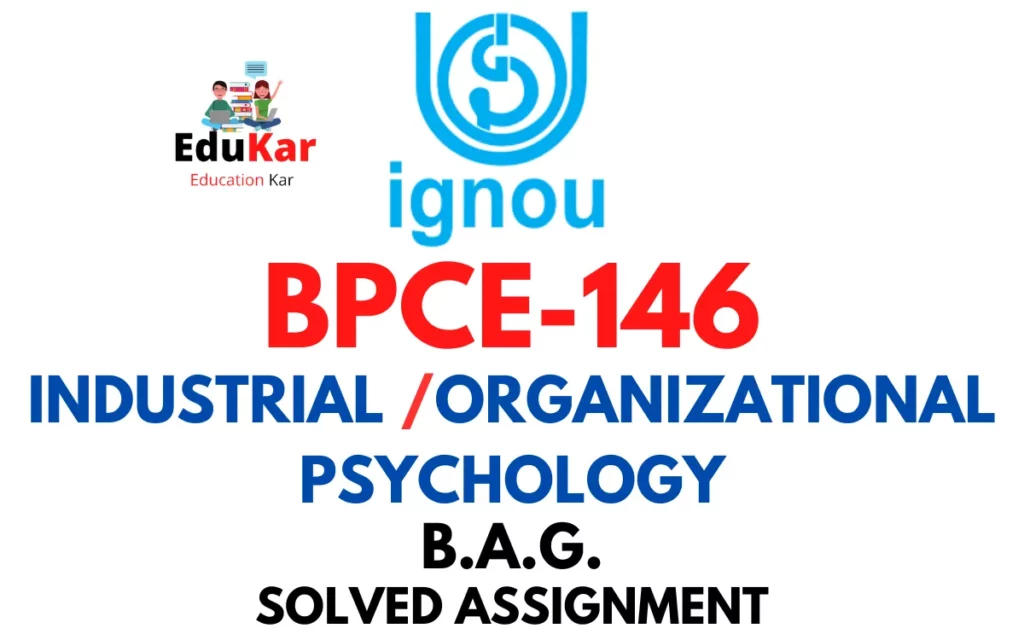



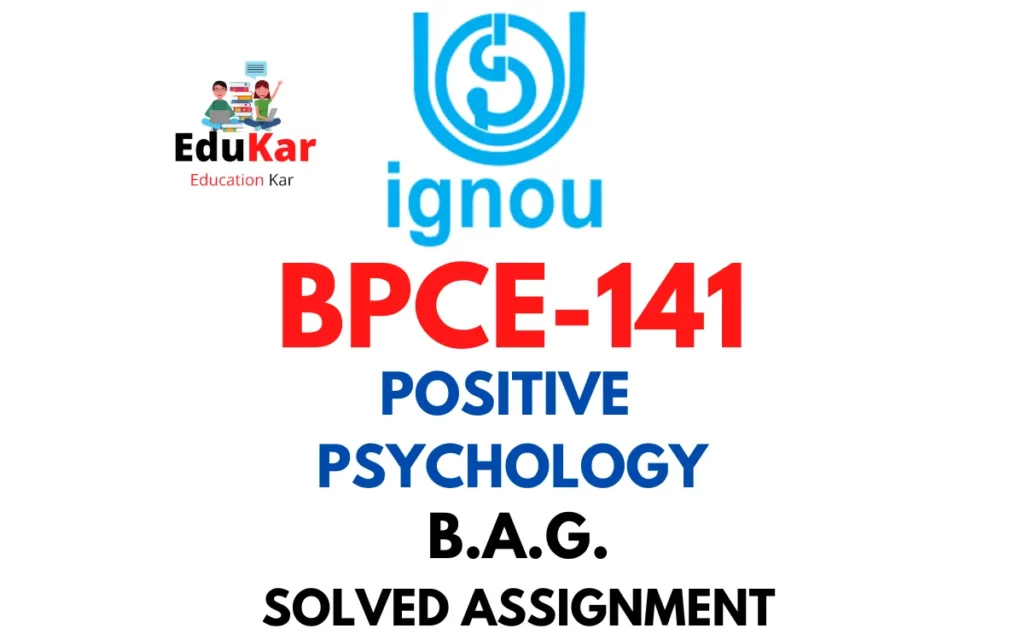
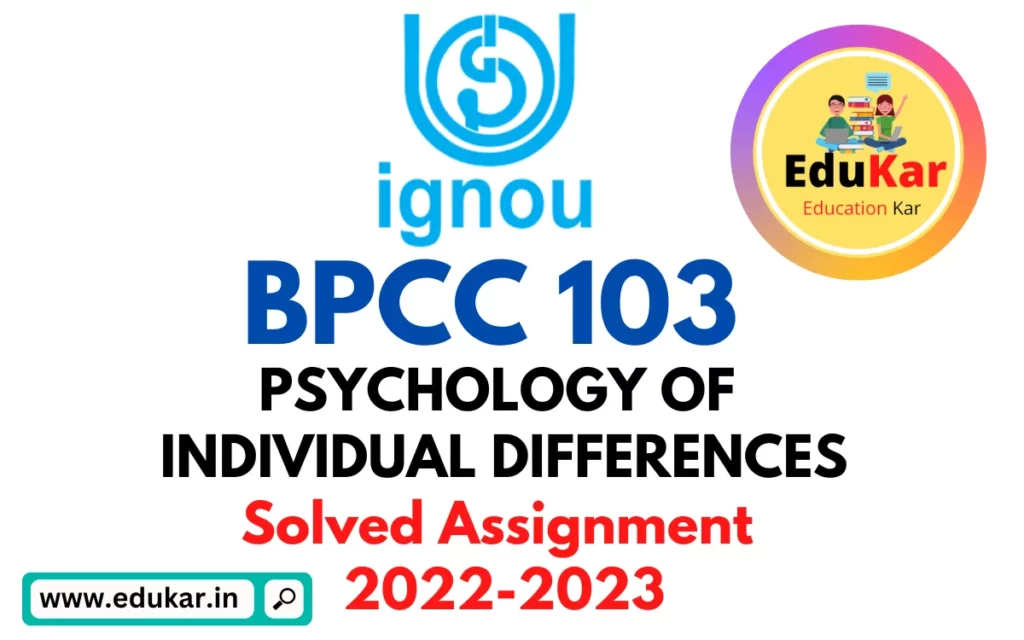
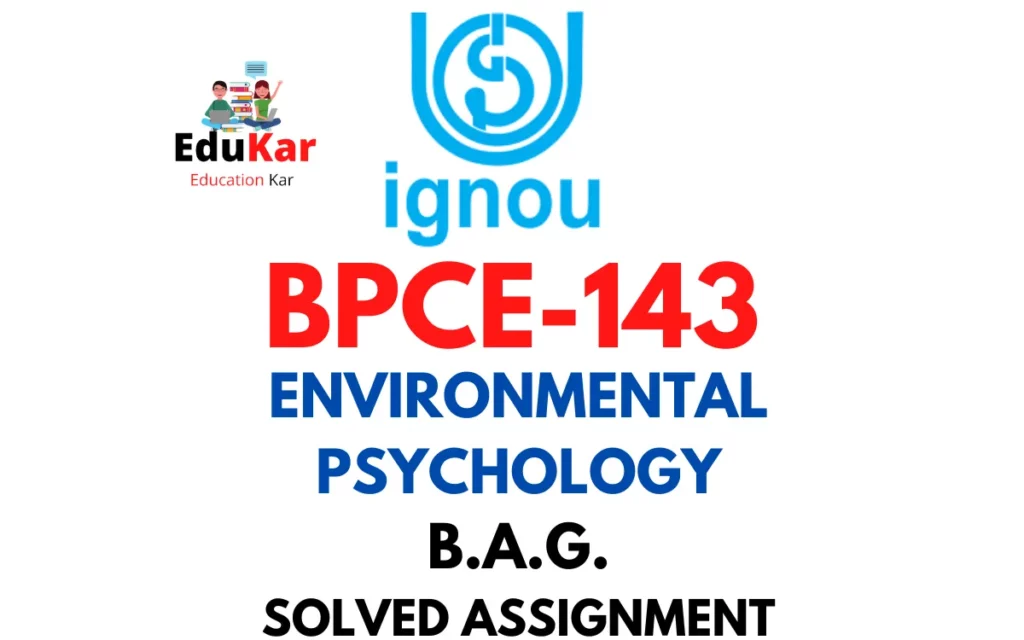

![[Solved Assignment] BPCS 188-APPLICATIONS OF SOCIAL PSYCHOLOGY (IGNOU-BAG) 2022-2023 BPCS 188-APPLICATIONS OF SOCIAL PSYCHOLOGY IGNOU BAG Solved Assignment 2022-2023](https://edukar.in/wp-content/uploads/2023/01/BPCS-188-APPLICATIONS-OF-SOCIAL-PSYCHOLOGY-IGNOU-BAG-Solved-Assignment-2022-2023-1024x640.webp)
